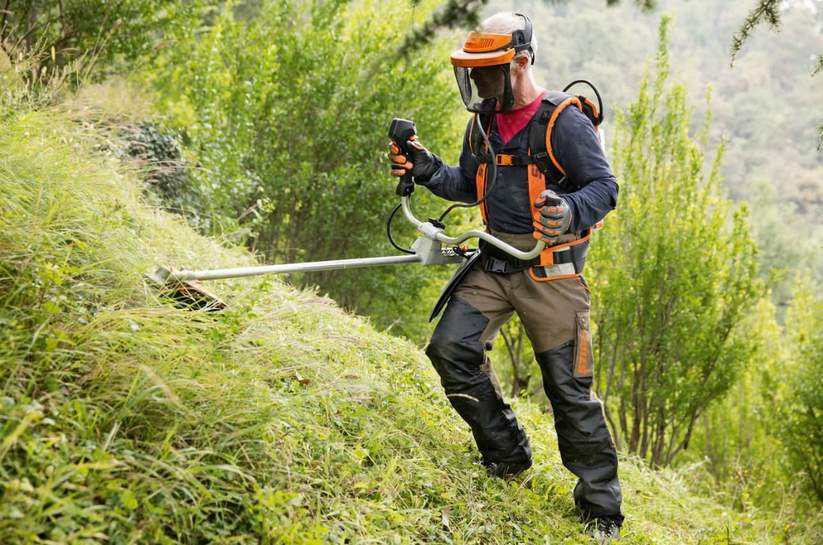A brushcutter is a powered garden or agricultural tool used to trim grass and weeds, and even small saplings, and foliage not accessible by a lawn mower and too extensive to cut by hand.
Brushcutters are basically a much bigger version of a domestic string trimmer (known in some countries as a “strimmer”, and sometimes called a “weedeater”). Whereas a domestic string trimmer will have a bent shaft, (with the drive shaft inside the shaft tube thus being made of flexible nylon) a brushcutter will have a straight shaft with a metal drive inside, the correct angle for the cutting implement being achieved by a gear mechanism at the bottom of the shaft.
With a bigger, more powerful motor than a string trimmer, the weight of a brushcutter often necessitates the wearing of a harness by the operator, to which the implement is attached.

On smaller models one usually has a choice of handles, namely handlebars that protrude from either side of the shaft and enable one to control both the swing of the machine and the height of the cut, or smaller handles similar to those on a weedeater.
The business end can be changed according to the task being undertaken, from nylon string, to a three-or four-bladed revolving blade, to, in the biggest models, a circular saw for cutting bigger saplings.
Recently, a number of non-original cutting heads have come on to the market. One is an imported head that looks like an oversized circular wire cup brush for clearing weeds from between paving and up against walls.
Another is a locally-designed head comprising three short lengths of bicycle chain affixed to a circular disk that will replace a conventional nylon line head and a steel blade.
If you are tempted to change to either of these innovations beware, say registered brushcutter dealers. For a start, fitting such devices will instantly void any manufacturer’s warranty you may have on your machine.
Secondly, in the case of the wire cup there is excessive vibration in use, and bits of the wire brush that detach themselves have the potential to cause serious injury.
This is even worse in the case of the bicycle chain heads: if a link of chain should detach in operation (which it surely will with wear and tear) it has the kinetic energy not dissimilar to a small bullet.
For the average smallholding, an intermediate unit is probably ideal because, unlike the machines used by the groups one sees swinging away at the grass on the sides of highways, your brushcutter is not going to be working seven days a week throughout the season.
Choosing your machine
- Go for a straight-shaft unit that comes with both a nylon-line (string) cutting head and a blade. The nylon-line cutting head should be of the “bump-feed” type. In other words it should have a store of line inside a housing which, on tapping it on the ground while it is revolving, will allow a few centimetres of line to come out of the housing.
- Go for the lightest unit you can find, even though it should be supplied with a body harness. Decide which type of handle works best for you.
- Try for one which has some form of vibration suppression to prevent your hands from becoming numb with extensive operation.
- Technically, fuel consumption and power are important. Most are powered by conventional two-stroke pull-start units, although emission legislation which is now demanding better fuel efficiency has resulted in modified four-strokes on some makes.
- The nature of the drive shaft and the bearings that house it will give an idea of how well the unit will last in operation.
- Ensure you have the proper protective gear with which to operate it (eg, boots, trousers and face/headwear with built-in earmuffs).
With this set-up you will be able to maintain your lawn edges, trim the weeds around your paddocks and on your verges, and also chop away small scrub and dry veld grass with the blade fitted, for making firebreaks.
Only, therefore, if your plot is overrun with small saplings will you need a larger brushcutter fitted with a saw blade – these are the units of the professional and are more expensive and heavier than most smallholders will ever need.

